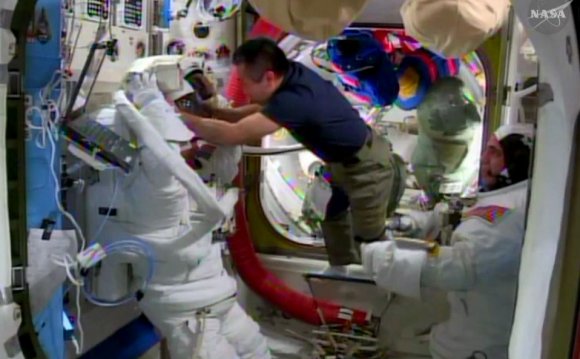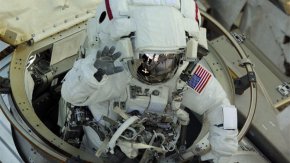
 Floating in the Quest airlock compartment, the astronauts plan to switch their spacesuits to battery power around 7:10 a.m. EST (GMT-5) Friday to officially kick off NASA EVA-33.
Floating in the Quest airlock compartment, the astronauts plan to switch their spacesuits to battery power around 7:10 a.m. EST (GMT-5) Friday to officially kick off NASA EVA-33.
Reversing their roles in an Oct. 28 spacewalk, Lindgren, call sign EV-1, will be wearing a suit with red stripes and serve as the lead spacewalker, using helmet camera No. 17. Kelly, EV-2, will be wearing an unmarked suit and use helmetcam No. 18.
The primary goal of the spacewalk is to reverse steps that were taken in 2012 to isolate an ammonia leak in the coolant system of the outboard P6 solar arrays positioned at the far left end of the station's main power truss.
The P6, or port 6, solar array truss segment was the first set of arrays launched to the station, temporarily mounted atop the Z1 truss segment extending up from the central Unity module. After the station's football field-length main power truss was built, P6 was moved from atop Z1 and attached to the far left end of the main truss.
Before it was moved, however, engineers noticed a small ammonia leak amounting to about 1.5 pounds of coolant per year. They projected the system would remain fully operational for three to five years before repairs or additional ammonia was required.
But after P6 was moved to its permanent location on the port end of the power truss in May 2011, the leak rate worsened, raising the prospect of a cooling system shutdown by the end of 2012 or shortly thereafter.
So in November 2012, spacewalking astronauts, in a bid to pinpoint the leak's location, re-extended a spare P6 radiator that was used during the station's initial assembly and relied on it for cooling. The normally used radiator and its plumbing were isolated, but the leak persisted.
Station commander Scott Kelly snaps a 'selfie' outside the International Space Station during an Oct. 28 spacewalk.
NASA
Then in May 2013, the station crew noticed ammonia ice crystals spewing from a line near the port coolant pump assembly. The pump was replaced during a subsequent spacewalk and the leak disappeared.Station engineers now want to return the P6 system to its original configuration, topping off coolant in the system to replace the ammonia lost to date, folding up the spare radiator and re-activating the normally used panel.
"There are eight power channels on ISS and they're associated with the large solar arrays that are on either end of the truss, " said flight director Mike Lammers. "Each one of those eight power channels has its own small ammonia cooling system with a pump package and a radiator. It's mainly there to cool (array) batteries and avionics.
"We have a little bit of a history on the system that's out on the port side in the P6 truss. It had a very slow leak that we'd been tracking for a number of years and in our telemetry it actually started to worsen a little bit as we were monitoring it in 2012."
"It's not always easy to isolate a leak, and it's a little bit more complex when you're talking about hardware that's outside, " Lammers said. "But typically what you do is you try to isolate individual parts of the system (to locate a leak) and we started doing that with an EVA on Nov. 1, 2012. We bypassed part of the system by moving its ammonia lines, connecting it to an older system that happened to be in the P6 truss from (initial) assembly and we also deployed a spare radiator that's called the trailing thermal control radiator."
 But the culprit was the pump assembly and when that unit was replaced, the leak went away.
But the culprit was the pump assembly and when that unit was replaced, the leak went away.
"The system is now leak tight, and we know that original radiator is in good condition, " Lindgren said last month. "So the purpose of the second EVA is to go out, re-integrate that original radiator back into the system, fill the system up with ammonia and then stow that backup radiator so it can be used in the future if we have trouble again."
Easier said than done.
The reconfiguration will require Kelly and Lindgren to install a long ammonia jumper across the large solar alpha rotary joint that rotates the arrays to track the sun, to pump coolant to the original radiator and to drain the spare radiator before it is folded up.
The work will require manipulation of occasionally finicky quick-disconnect fittings and the astronauts will have to take care to prevent any escaping ammonia from getting on their spacesuits. If that happens, they will have to spend extra time in the airlock at the end of the spacewalk to "bake" out any trapped ammonia ice crystals before repressurizing the airlock.
After exiting the Quest airlock, Lindgren and Kelly will make their way to the far left end of the station's power truss and drive a bolt, opening a valve that will allow ammonia to flow back into the normally used radiator and its plumbing later in the spacewalk.
Lindgren will then close valves that will break the connection between the original radiator and the spare. Kelly, meanwhile, will install a long jumper that will allow ammonia stored in a tank near the center of the power truss to reach the outboard radiators across the solar alpha rotary joint.
After venting the fill line, Kelly will reposition a jumper at the tank to allow ammonia to flow through the fill line. Both radiators and their associated plumbing will be topped off with coolant.
After venting the supply line and the spare radiator, Lindgren then will use a power tool to drive a bolt that will retract the spare radiator panel. The fill line will then be vented to make sure no ammonia is trapped inside.
Before removing the long jumper to disconnect the fill line, the astronauts will use a power tool to tighten a pair of bolts on a presumably loose strut near the port-side solar alpha rotary joint. Telemetry indicates vibration in the system, and the bolt tightening may resolve the issue.
After breaking down and stowing the ammonia fill line, Kelly and Lindgren will cinch down the folded radiator and install a thermal blanket. In a final task, Kelly will reconfigure a cart attached to the mobile base system that allows the station's robot arm to move from one worksite to another.
During a spacewalk Oct. 28, Kelly and Lindgren carried out routine maintenance and laid out power and data cables needed for new docking mechanisms that will be installed later.
RELATED VIDEO












